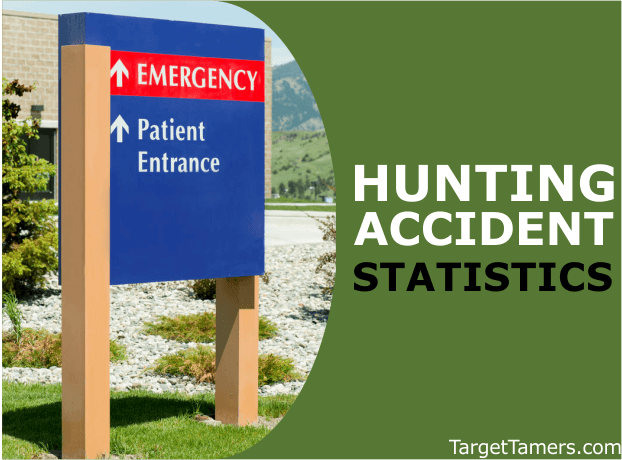
In 2016, over 103 million U.S. residents enjoyed wildlife-related activities of some sort.
While angling and wildlife observation were the most popular activity, more than 10% were hunters[1].
Be it deer, moose, bear, hog, coyote, turkey, duck – hunting is a popular sport, lifestyle, and means of income for many Americans.
However, not unlike many other outdoor activities, there is risk for injury and even death. What’s the likelihood of being hurt or even killed in the hunt?
Let’s check out the stats!
Key Takeaways:
- Compared to other sports including baseball, football, basketball and running/jogging, hunting is ranked as one of the safest.
- Most accidental deaths by firearms do not involve hunters.
- State data indicates that hunting fatalities are in the single digits for any given year.
- Many hunting accidents are the result of lacerations while field-dressing game, tree stand accidents and trips and falls, not firearm related.
- Weapon-related injuries are on the decline, but elevated tree stand injuries are on the rise.
- 95% of serious injuries related to tree stands are due to hunter not wearing a full body harness.
What is a Hunting Accident?
It’s not the minor mishap where a good goose-egg is the story of your hunt. The kind of accidents we’re about to discuss are the major ones where there is an injury that requires a visit to the emergency room, a major injury like falling from a tree stand, and an accidental discharge of a firearm or bow.
Every state has laws and policies in place to provide recourse for a direct or indirect personal injury or death caused by a sporting arm. But, most importantly, educational and prevention programs are provided nationwide with local support to ensure hunting remains a safe activity[2].
This begs the question, how safe is hunting?
Of multiple sports that includes baseball, football, basketball, running/jogging, and more, hunting is ranked as one of the safest activities to participate in[3].
How many people will experience an injury during hunting season? Perhaps past year statistics will shed some light.
Hunting Fatality Statistics
In 2019, over 15 million people paid for hunting licenses across the U.S.A. with over 1 million of them from Texas alone[4]. Pennsylvania comes in second with over 956,000 paid-for license holders with Wisconsin, Minnesota, and Georgia bottlenecking in the high 600,000 range. With such high numbers of gun and bow-wielding hunters out in the wild, fatality numbers are astoundingly low.
50.5%
The measure of the decline in unintentional firearm fatalities from 1997 to 2017.
Over the past 20 years, unintentional fatalities by firearms has been on the decline. From 1997 through to 2017, it's dropped by 50.5%. When comparing firearm fatalities to poisoning, fire, motor vehicles, drowning, and more, unintentional firearm fatalities within the total U.S. population makes up only 0.3% of accidental deaths over the entire two-decade span[5]. And, it should be noted that when it relates to hunting-specific activities, the number of accidental fatalities by firearm, including bows and crossbows, is significantly less.

1 in 6,905
The odds of dying from a firearm discharge according to the NSC in 2017.
According to the stats by the NSC (National Safety Council) in 2017, the "odds of dying from" a firearm discharge is 1 in 6,905. Although, it must be said that most accidental deaths by firearms do not involve hunters[6]. To prove this point, the NSC says of all gun-related deaths in 2017, 60% is due to suicide and 37% to homicide – unrelated to hunting[7].
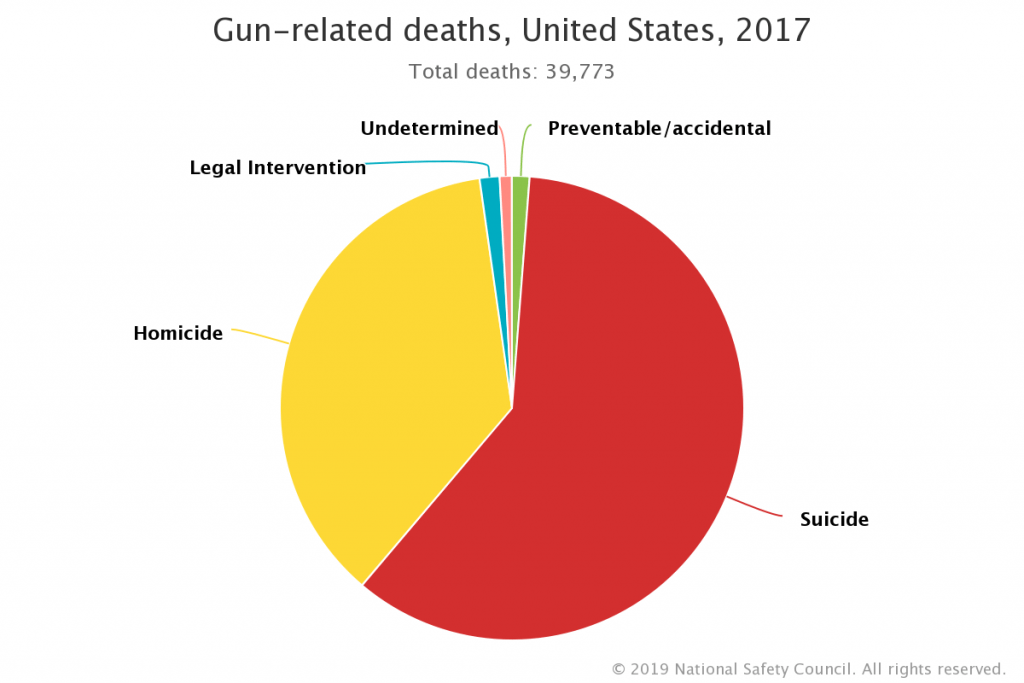
<100
The number of hunting fatalities per year.
The IHEA-USA (International Hunters Education Association) compiled data for years 2002-2007 that shows significantly less than 100 fatalities a year. The same report shows a sharp decline of all hunting injuries and deaths with less than 1000 total incidents every year for all 50 states. In 2007, there were less than 300 total incidents and 25 fatalities[8].
$670 million
Spent on safety training and educating hunters between 2013-2017.
The decline in hunting fatalities is largely due to educational programs supported by the NRA, NSSF, and several federal and state government agencies. From 2013-2017, more than $670 million from excise taxes was granted to states specifically to support safety training and hunter education[9].
Additionally, technological advancements, safety gear including hunter-orange clothing, firearm locking devices, and other safety equipment designed by gun and outdoor gear manufacturers all work to bring down injury and death-related incidents every year. Strict regulations around the usage of night vision and thermal devices also contributes to improved overall safety.
10 Hunting Accident Statistics by State
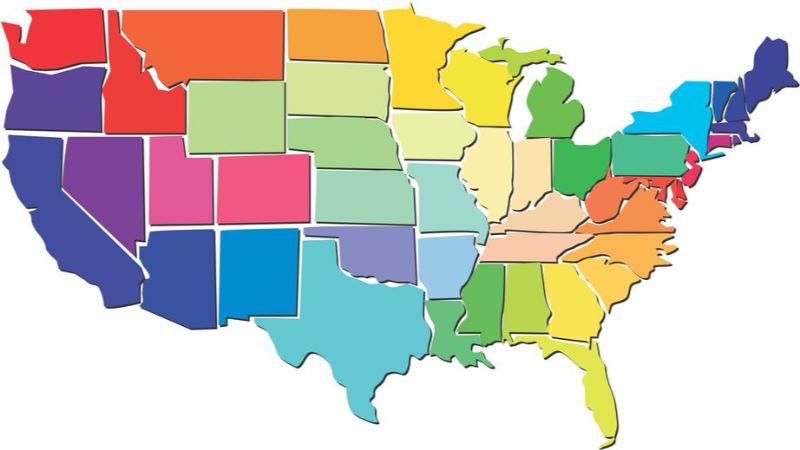
How many hunters are really dying from gun or bow-related injuries?
In 2007, the Hunter Incident Clearinghouse reported 239 firearm-related (shotgun, rifle, and “other”) incidents in all U.S. states of which 19 resulted in fatalities[10].
Current data by state shows fatalities are in the single digits for any given year. However, there is very little, up-to-date research and data available, and what little does exist is unorganized and difficult to access, verify, and corroborate. But, we did some digging and found 10 recent statistics we were able to put together.
Illinois 2018
- 4 incidents involving discharge of firearm (3 minor/1 major injuries/0 fatalities)
- 9 major incidents from falling from a tree stand
- 6 major incidents from installing tree stands
- 1 fatality due to heart attach while in the field but not from the act of hunting[11]
Iowa 2018
- 6 DNR investigations (4 hunting related/1 fatality/1 other)[12]
Minnesota 2018
New York 2018
- 13 firearm injuries of which 3 were fatalities[15]
- 5 tree stand injuries[16]
- Update: According to the Department of Environmental Conservation's Hunter Education Program, hunting accidents in New York hit an all-time low in 2021. Of the 9 incidents recorded, 2 were self-inflicted, 7 were two-party firearm incidents and there was one fatal injury. This makes 2021 the safest year on record for hunters in New York.
North Carolina 2015-2016
- 3 fatalities (2 firearm-related/1 non-firearm-related)
- 21 non-fatal injuries (13 firearm-related/8 non-firearm related)[17]
Ohio 2014
- 13 incidents (3 fatalities/10 injuries)
- 1 out of every 37,500 hunters in Ohio was injured in a hunting-related shooting accident[18]
Pennsylvania 2018
- 27 incidents including 1 fatality[19]
Texas 2018
- 17 incidents (14 non-fatal and 3 fatalities)[20]
Utah 2017
- 7 hunting incidents which includes 1 fatality[21]
Wisconsin 2018
- 17 incidents including 2 fatalities[22]
Hunting Injuries and Accidents
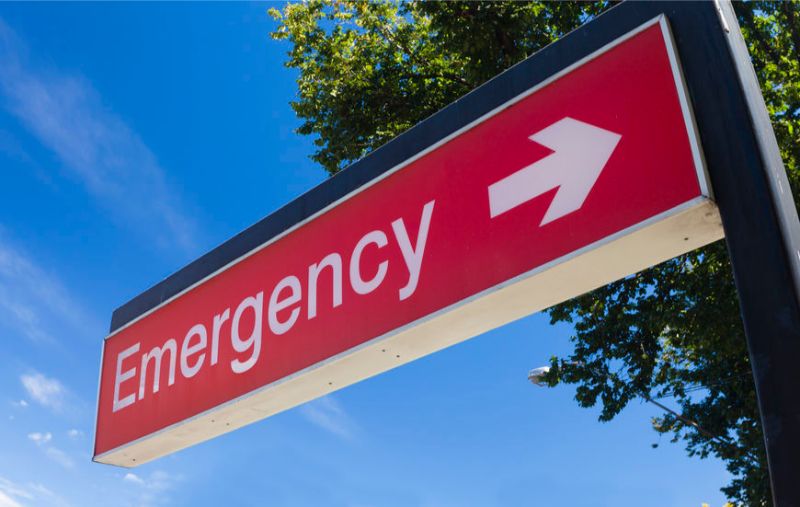
It’s clear by now that “hunting accidents” is a catch-all term.
It can be defined by injuries occurred in the field and not necessarily by an unintentional discharge of a sporting arm.
Many major injuries experienced during hunting season are due to lacerations while field-dressing game, tree stand related accidents, and trips and falls that result in cuts, broken bones, immobility, and possible death.
17 Million
The number of hunters with firearms in 2017.
In 2017 there were over 17 million hunters with firearms according to the NSGA (National Sporting Goods Association), and only 35 injuries occurred per 100,000 participants of which a vast majority were non-serious injuries[23].
The same compilation of data calculated the following versus hunting:
- 130 times more likely to be injured playing football
- 62 times more likely to die in a car accident
- 58 times more likely to be injured playing basketball
9 per 1 million
The estimated number of days with firearm injury associated with hunting activities.
A Political and Social Research Firearm Injury Surveillance Study accumulated data from 1993 to 2008[24].
- 1,841,269 emergency department (ED) visits from firearm related injuries (both hunters and non-hunters).
- Only 1.95% (35,970) of these ED visits were hunting related.
- Among the 1.95% of hunting injuries, 57% of the firearm incidents resulted in being shot while 44.2% were lacerations, and the mortality rate was 0.6%.
- 4% of these hunting-related injuries were unintentional.
- The study also observed that firearm-related incidents occurs in only 9 per 1 million hunting days.
From the data, you're more likely to be injured by a firearm in a situation unrelated to hunting than to be shot or hurt by a firearm while hunting.
<1%
The percentage of Emergency Department visits resulting from gun-shot wounds.
A 9-year analysis in Western Colorado reports there were 725 big-game hunter ED visits, an average of 80 per year. Gun-shot wounds made up less than 1% (4), and there was only 1 firearm-related fatality. The most common reason for medical treatment was for cardiac disease and lacerations occurred during field-game dressing[25].
Hunting Tree Stand Accidents

Modern elevated tree stands have been around for decades, and most tree stand related accidents are falls while climbing into and out of the stands.
Many falls result in a bruised rear-end and winded solar plexus, but some falls from an elevated position can have some dire and deadly consequences.
31%
A 2017 Multi-State Analysis reports that of all elevated tree stand types, 31% of injuries occur with the lock-on type followed by 25% with the climber type and tying at 20% is the ladder and DIY (home-made) versions[26].
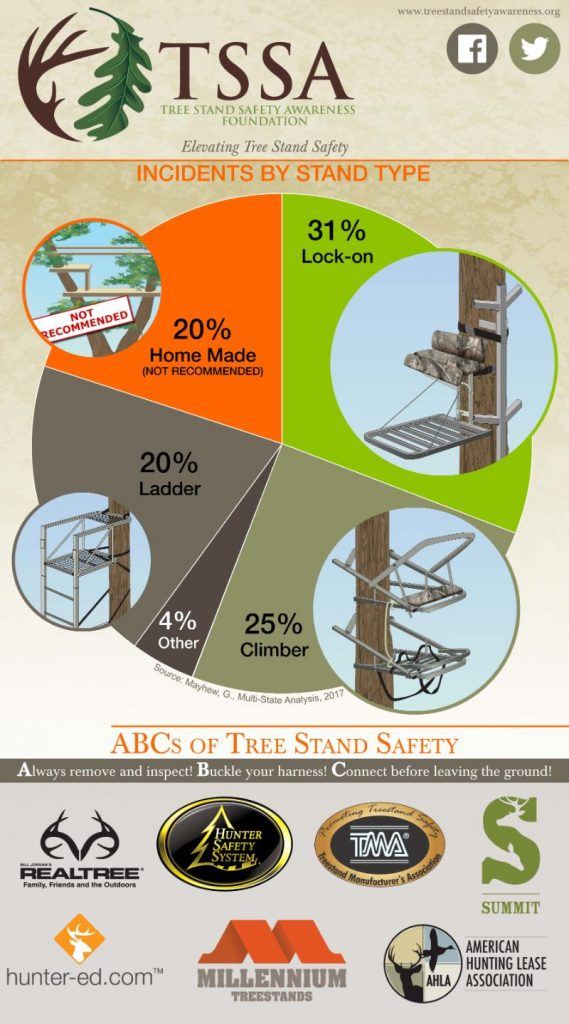
95%
John Louk, executive director of TMA Stands, states that 95% of serious injuries relating to tree stands are due to hunters not wearing a full-body harness[27].
2002
Way back in 2002, IHEA conducted a survey[28] consisting of 1056 hunters in North Carolina and Vermont states. Only 7% of hunters who used tree stands had an accident mostly related to not wearing a fall-restraint device. These accidents were falls when ascending or descending a tree stand. It’s also worth mentioning that most of this 7% said their stands were not defective, but they did not do all they could have done to prevent the accident including not having a safety or shooting rail.
Guess what these hunters did after that experience? They took extra precautions and changed their technique to improve hunter safety. While weapon-related injuries may be on the decline, elevated tree stand injuries may be on the rise.
This same study asked participants how concerned they are with tree stand hunting accidents, and 80% expressed they were “somewhat or very concerned.” Interestingly, 52% admitted they aren’t as diligent at practicing safe hunting techniques from an elevated hunting position because they don’t think they are likely to be injured – a common hunter attitude. To further support this way of thinking, 79% are confident they won’t experience an injury in a fall over the next two years from the time of the study as 57% reckon these types of accidents occur because of carelessness.
1999-2013
A comprehensive review of the University of Wisconsin Hospital and Clinic’s trauma database reveals 117 patients from 1999 to 2013 fell from tree stands with the majority suffering from spinal fractures. 5 of the 117 injuries resulted in paralysis[29].
During 1999-2004, the University of Wisconsin Hospital recorded 24 hunters that required inpatient care with only 8 related to a firearm accident. 16 of those patients fell from tree stands with 2 resulting in death[30].
Another study, this one over a 10-year period from 1995-2005, reviewed the medical records of 22 patients with spinal cord injuries from falling from tree stands[31].
5,686
In 2005, approximately 5,686 injuries were related to tree stand use. The CPSC (Consumer Product Safety Commission) states that many tree stand injuries were directly related to falls without use of a safety restraint harness, and yet, there are legitimate concerns regarding full-body harnesses such as suspension trauma[32].
Global Hunting Accident Statistics

The United States is not the only country to experience hunting incidents. In fact, it’s a worldwide matter of interest.
Here are some interesting hunting accident stats from a very short list of countries where we could find the data.
It’s unfortunate that hunting accident statistics are not easily accessible if they exist at all, even for popular hunting destinations such as South Africa, Argentina, the UK, and more.
Australia
A report covering 10 years, 2000-2010, investigated 25 firearm related fatalities. Some were actively killed during the act of hunting while others were killed from a discharged weapon while traveling related to hunting[33].
Canada
Canada has little research and statistics when it comes to firearm related injuries. However, a study in Quebec reports that 37% accidental deaths occurred from some type of hunting incident. “5 percent occurred when the shooter was carrying a firearm; 48 percent occurred during other activities. In 55 percent of cases, the shooter accidentally shot himself[34].”
France
The ONCFS, a French national agency for wildlife, acknowledges the downward trend of hunting-related incidents over a 20-year period. During 2017/2018 hunting seasons, they reported 113 hunting accidents – a historic, all-time low[35].
New Zealand
There are 195,098 hunters each year with more than 28,000 international visitors. 41 hunting-related fatalities were reported from 2007-2016. Over a 5-year period, 582 hunters were missing and/or rescued. Of 12,628 total injuries from 2004-2016, falling is the most common type of injury making up 33.7% of hunting-related accidents[36].
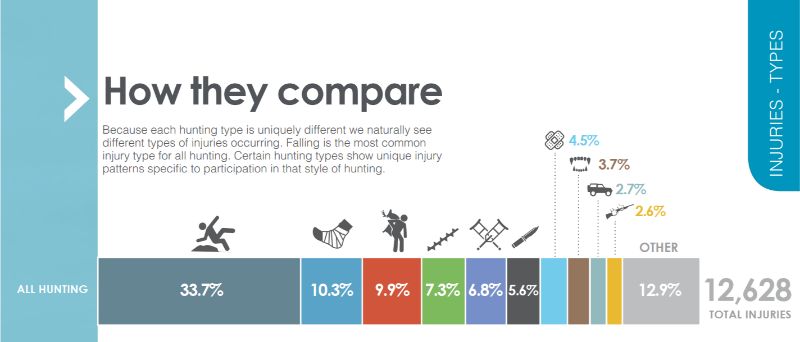
Sweden
From 1983 to 2008, 48 unintentional firearm fatalities were reviewed. 41% of victims were misidentified as game during moose hunting season, 31% of fatalities were due to falls during small game hunting, and 15% was the result of improper handling of a firearm. 88% of an approximate 2 million firearms in Sweden are registered strictly for hunting. Each hunting season, Sweden has 290,000 hunters with 28,000 international visitors for the sport according to data collected from 2012-2017[37].
Switzerland
19 patients admitted to the Emergency Department at Bern University hospital during the years 2000 to 2014 were reviewed to identify patterns in nonfatal hunting accidents. The most common injuries were firearm-related and falls[38].
A Hunting Tale of Numbers

These numbers tell a story – a story of how hunting related injuries and fatalities are on the decline. For most states in the U.S. and countries around the world, these numbers are telling a tale of historic lows.
However, statistics will vary between multiple sources for limitless reasons. Some of the ‘most recent’ data is over a decade old. This only corroborates the need for more research and studies into hunting-related accidents and fatalities as there is a notable lack of usable, accurate, and up-to-date statistics.
But, more important than numbers is a like-minded connection. Not only is it fair to say hunting is a way of life for several millions of people in the North American continent, hunting is a passion shared by people across the globe that unites us in the most primitive way.
Most countries acknowledge this wildlife activity as a safe and enjoyable pursuit. Accidents are not exclusive to this type of venture, and so it’s essential to take precautionary measures to increase safety whenever you head out with a rifle, bow, or tree stand in whatever state or country you find yourself in next.
Resources:
[2] Hunting Safe Activity Chart
[4] WSFR Programs hunting licenses 2019
[5] Firearms Related Accidents Statistics
[7] NSC Injury Facts/Safety-Topics/Guns Statistics
[8] IHEA-USA 2002-2007 Incident Reports
[9] Firearms Related Accident Statistics
[10] IHEA/HIC 2007 Incident Statistics
[11] Illinois DNR Hunting Incidents 2018 Summary
[12] Iowa DNR News Release
[13] Minnesota DNR Hunting Incident Report
[14] Minnesota DNR Hunting Accidents Report
[15] New York DEC gov report
[16] New York DEC gov tree stand report
[17] North Carolina NCDCR report
[18] Ohio DNR Wildlife Hunting Publication
[19] Pennsylvania Hunting Related Shooting Incidents Summary
[20] Texas TPWD Hunting Accidents Report
[21] Utah Hunter Education Public Accident Report
[22] Wisconsin DNR Incident Report
[23] Firearms Related Accident Statistics
[24] Injury Journal/A Political and Social Research Firearm Injury Surveillance Study
[25] Western Colorado 9-year study
[26] Multi-State Analysis Report/Chart
[27] “Fall-Arrest Systems Saves Lives” article
[28] IHEA-USA Elevated Stand Report
[29] WI Medical Society Publication report
[31] The Spine Journal Online article abstract
[32] CPSC Voluntary Standards Hunting Tree Stands
[33] “Australian External Cause Deaths Engaged Hunting Activities” PDF
[34] Canada’s System of Justice Updated Review
[36] NZ Mountain Safety Council’s “A Hunter’s Tale”




I am looking for any statistics on the number of firearm injuries that involve the loading and unloading of firearms while hunters are in the field, I.E. during the activity of hunting. Any stats?
Hi Dan. I've found it difficult to narrow down the parameters to just injuries from loading/unloading firearms while in the field, but this IHEA database resource might help you to gather more information. I think the classifications you'll find interesting will be "Hunting incident involving a shooting by a gun or bow" and "Shooting while engaged in legal hunting activity." Also, here's a link to the most recent NSSF statistics (2018). I don't know if that will help but it's interesting. Sorry I couldn't narrow down some stats related to your parameters. Other things like stumbling, dropping the firearm, and defective ammunition seem to be the
'common' causes of firearm injuries rather than loading or unloading a firearm. Goodluck in your search!